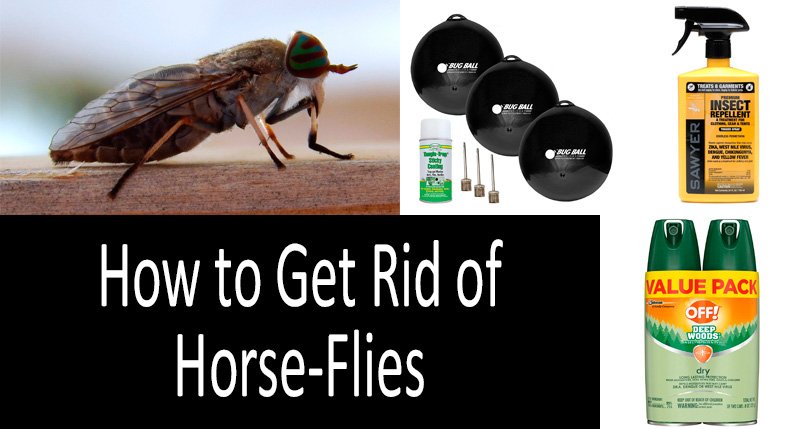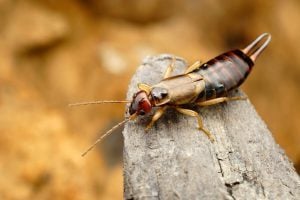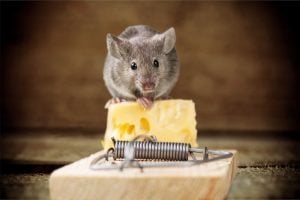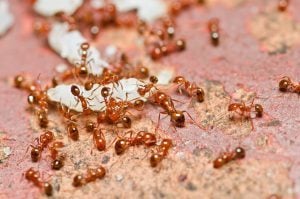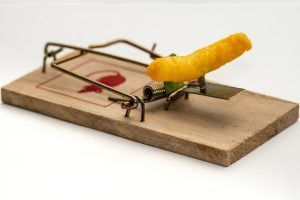These bloodsuckers become active when the breeding season starts,mostly in the summer, attacking their victims in groups. Why do horse-flies bite? It is only females that bite, which is due to their need to obtain enough protein from blood to lay eggs. What makes horse-flies more annoying than mosquitoes is their size. Horse-flies are much larger and, therefore, need more blood for reproduction. That is why they are so aggressive, attack pretty frequently, and bite painfully.
How to get rid of horse-flies? Much depends on what problem you are facing. If you need a solution for personal protection, apply insecticides based on DEET and Permethrin to your skin and clothes respectively. To protect your livestock, choose insecticides formulated for application directly to animals. To keep horse-flies away from your yard, treat the vegetation outside the house with insecticides containing Pyrethrin and Piperonyl Butoxide.
However, a universal solution is to place traps. While being the safest yet effective way to get rid of horse-flies, trapping is a great tool for cattle protection against these pests, keeping your yard free of horse-flies, and will also be useful during camping. That said, it is crucial to set the right traps, which are designed in accordance with horse-fly biology, like the Bug Ball The Kit Deluxe. Developed specifically for horse-flies, the trap comes with a large black PVC ball and a molded loop for hanging. The large black object attracts these insects, while Tangle-Trap bug adhesive catches them.
{code 1165}
Now, let’s look into the most efficient methods of horse-fly control.
Keep Horse-Flies from Biting with DEET & Permethrin
Horse-flies are attracted to shiny water, which is why they are common around swimming pools and at the beach. If you do not want to let them ruin your recreation, use FDA-registered repellents for personal protection. These products can be roughly divided into two categories: insecticides applied directly to the skin and those labeled for clothing treatment.
The most potent and effective ingredient used for application to clothes is Permethrin. This chemical compound acts as a repellent, however, it keeps insects from biting, not landing on your clothes. Permethrin kills or causes muscle spasms in insects upon contact and is highly toxic to a wide range of pests.
The biggest advantage of this option is the long-lasting repelling effect. For example, the Sawyer Products Premium Permethrin Repellent lasts up to six weeks and withstands several washings. Keep in mind that insects may continue to fly around you even after the treatment, but they will not bite you. For better protection, we recommend taking additional measures like wearing light-colored clothes and hats.
{code 1166}
Another option is a DEET-based insect repellent that is intended for skin application. This ingredient, also known as diethyltoluamide, was developed 80 years ago and is the most time-honored insect repellent. The concentration of DEET ranges from around 10% to over 90%. Clearly, the more concentrated the insecticide, the more potent the effect. However, highly concentrated DEET repellents are not the most recommended ones because of safety hazards they may pose. Basically, the middle ground is somewhere around 20% to 30%, when the repellent is powerful enough but not too much to cause side effects.
The OFF! Deep Woods Insect Repellent VIII Dry meets these requirements and is both efficient and safe. The formula contains 25% DEET and provides about 5 hours of protection. This non-greasy solution comes in an aerosol spray can and is very easy to use. The insecticide repels insects in the harshest conditions and is a perfect choice for hiking, camping, and hunting. The formula works against biting flies, mosquitoes, and many other pests.
{code 1167}
So what repellent is the most effective — DEET or Permethrin? Actually, this question is not correct because scientists recommend using simultaneously both repellents, skin and clothing ones.
Horse-Flies Traps
Depending on what you need to protect, you may choose a light trap, a disposable trap, a CO2 trap or a ball trap. The light traps can be used to keep horse-flies away from your yard. They work well because horse-flies find their prey visually, responding to motion and shining surfaces. These traps attract insects with light and capture them using an adhesive layer or kill them with an electrical grid like the Flowtron BK-15D.
{code 1168}
Also, there are disposable traps like those made by Rescue. They are highly popular because of the low price and convenience of use. Place several such traps around the yard or the lawn where your cattle graze. Insects will enter the trap through the top cap and die by drowning in the water.
Another option is installing a trap that attracts insects with carbon dioxide (CO2). This works because animals and humans exhale CO2 while breathing, which is a welcome sign for horse-flies looking for blood. You may try the Mosquito Magnet MM4200B Trap that attracts biting insects with a combination of heat, moisture, and carbon dioxide. Once captured, they dehydrate and die.
{code 1169}
Meanwhile, the best trap is the Bug Ball The Kit Deluxe as it was designed specifically for horse-flies. It is a large water-resistant PVC ball that comes with a molded loop allowing you to hang the trap from a tree or a hook. Why is the ball black? It is common knowledge that horse-flies are attracted to large black objects, so this one will not go unnoticed. The product comes with Tangle-Trap bug adhesive that should be applied to the ball surface. This adhesive layer is safe for humans and pets, eco-friendly, and free of pesticides. To protect one acre of your property, you will need to place 2 to 3 Bug Balls, something that will cost you less than $100.

Use Insecticides To Kill Horse-Flies
There are two ways of insecticide application to get rid of horseflies: spraying plants or treating your cattle. If you want to kill these insects in your garden or yard, use commercial insecticides labeled for vegetables and ornamentals. Alternatively, you may make your own solution using soap and vinegar. Mix 4 tablespoons of dish soap with 2 cups of vinegar and a cup of water. Shake up the mixture well and pour it in a bottle with a sprayer. Use this homemade solution to treat plants and flowers in the yard.
Commercial horse-flies killers are based on Pyrethrin, which is a chemical compound extracted from the flowers of Chrysanthemum. This chemical affects the insect’s nervous system and often forces the bloodsucker to leave before it finishes feeding. The insecticide should also contain Piperonyl Butoxide, an ingredient that enhances the effect of Pyrethrin.
You may try the Southern Ag 10401 Natural Pyrethrin Concentrate that contains both these ingredients (0.96% Pyrethrins and 9.6% Piperonyl Butoxide). You can safely apply this product not only to livestock and pets but also to ornamentals and vegetables. One canister contains 8 ounces of organic insecticide concentrate that should be diluted at a ratio of 2 tablespoons per gallon of water. It is noteworthy that, unlike many other insecticides, this item was manufactured not by a company specializing in pest control products but by a company that works in the agriculture industry. Southern AG Carriers, Inc.has been producing pesticides, insecticides, fungicides, fertilizers, etc since 1943 and has earned the reputation of a reliable supplier.
{code 1170}
To treat cattle with insecticide, spray the solution directly on the animal or rub it on. Undiluted concentrates are more efficient as they can be applied in small amounts, whereas diluted insecticides need to be sprayed heavily on the animal to be effective. Do not apply the solution to dairy cattle before milking.
Rules for Getting Rid of Horse-Flies: Effectiveness Based on Scientific Research
Setting traps is a good option for protecting your yard from horseflies, says Michael Waldvogel, Entomologist at NC State Extension. This method is the most suitable one for those who need to control horse-flies in small areas or during outdoor activities like camping. The trap should have black sides and be suspended around 20 inches from the ground. When choosing the best location for your trap, make sure that there is not to much vegetation around it, he notes.
According to Robert Hall, Entomologist from the University of Missouri, horse-flies are hard to control by insecticides, especially when you need to protect your cattle. This is because horse-flies are large, tough, and very fast. Moreover, it is hard to find their breeding sites. At the same time, if you apply too much insecticide to an animal, you may cause it harm.
Still, the scientist recommends treating animals with Pyrethrin-based insecticides to decrease the number of bites. He advises purchasing concentrated solutions with about 1% of Pyrethrin that are intended for cattle. That said, Hall reminds us that dairy cattle should be treated with less concentrated insecticides.
Lee Townsend, Entomologist at the University of Kentucky, notes that while pyrethrins may have a quick knockdown effect, they are a short-term solution. Since pyrethrins are broken down by sun rays, they remain effective only for a couple of hours after application. For this reason, he recommends a longer-lasting alternative — pyrethroids like Permethrin, Cypermethrin, and Resmethrin. These are synthetic insecticides that are based on natural pyrethrins and provide protection lasting several days.
Products containing these ingredients can effectively repel bloodsuckers, so Townsend lists a number of brands suggested for this purpose. The Farnam Bronco e Equine Fly Spray contains Permethrin and is a non-oily repellent. The product is formulated for horses and should be applied with a trigger sprayer. Based on Cypermethrin, the Farnam Repel-X Lotion Fly Repellent for Horses is ideal for spot treatment. You can safely apply it around the animal’s eyes and ears. Moreover, you can treat areas around wounds with this insecticide. One application will last for around a week.
{code 1171}

